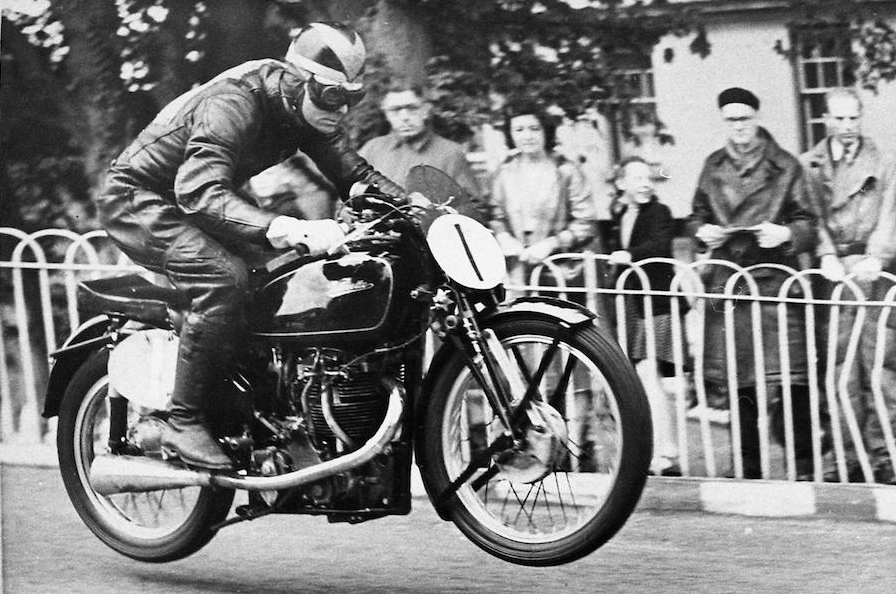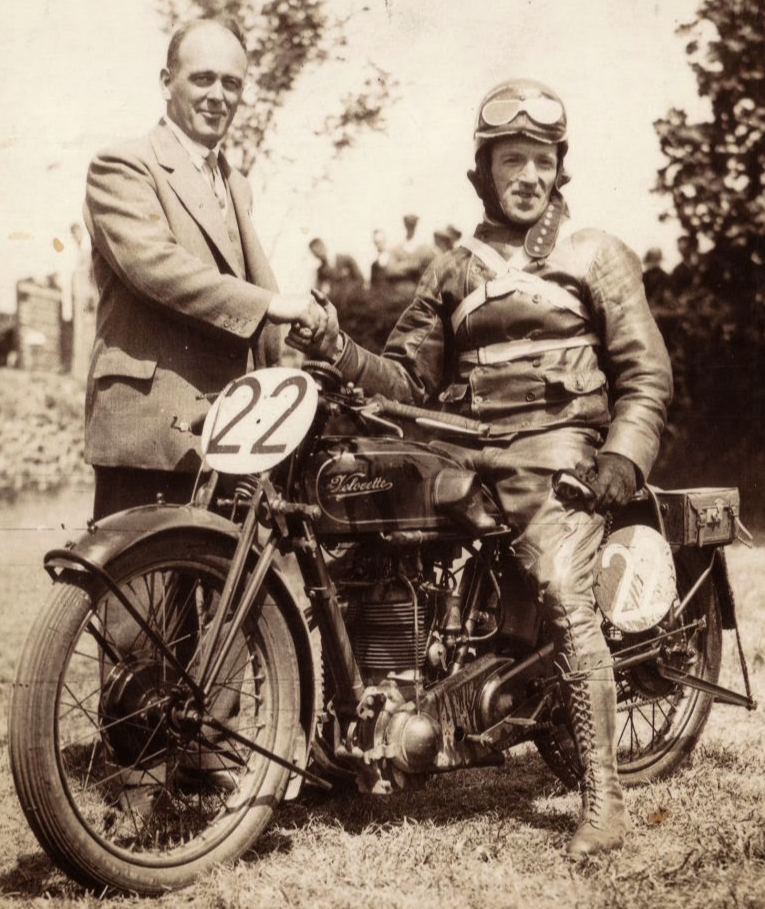Velocette - A Racing Heritage

Freddie Frith in action at the Isle of Man TT.
VELOCETTE RACING MOTORCYCLES
INTRODUCTION
From the beginning of the 20th Century until the Factory closed in 1971, Velocette remained under the control of one family, the Goodmans. Even more remarkable is that the family responsible for what many would consider to be the most English of motorcycles was of German origin.
In 1876 at the age of 19, Johannes Gutgemann came to England. After marrying Elizabeth Ore they had two sons, Percy and Eugene, and settled in Birmingham. Johannes adopted the English name John Taylor, but when granted British citizenship in 1911 he took the surname Goodman and the rest of the family followed in 1917.
The two sons pursued engineering careers and founded New Veloce Motors, intending to manufacture cars. Although a prototype was made no orders came. Percy then designed a motorcycle of quite advanced design. Again it was not well received and a more basic machine was made which sold well at 40 guineas (£42). This machine was known as the VMC (Veloce Motor Company) and it was the name "Veloce" that the Goodmans gave to their motorcycles until 'Velocette' was adopted for the first lightweight in 1913. For the next few years Veloce concentrated on high quality but rather staid motorcycles which met with considerable success in long distance trials and the like, but road racing results were disappointing.
By 1924 the company had noted the success of rival manufacturers using machines powered by overhead valve engines and Percy Goodman drew up a design for a new overhead camshaft engine. The new engine had to be as narrow as possible to fit into the existing frames, which had two-stroke engines. The result was an extremely narrow and very strong crankshaft capable of high revolutions without flexing. The design also gave all single cylinder Velocettes that unique feature where the clutch is inboard of the final drive sprocket. The bore and stroke of the new engine was 74 x 81 mm which remained the same for all 350cc OHC Velocettes. The new model was first exhibited at the 1924 Olympia Show. Once the usual teething troubles had been addressed, it became apparent that the machine had an outstanding performance. Two machines were entered in the 1925 IOM TT and, though neither finished, the Factory was happy with the overall performance. Shortly afterwards Alec Bennett the outstanding TT rider visited the Factory and it was announced that he would lead a team of three riders in the 1926 Junior, the other two team members being Gus Kuhn and Fred Povey. Bennett won by over 10 minutes and Kuhn and Povey were in the first ten ensuring Veloce also won the manufacturers' team prize. This was a remarkable success for such a tiny firm; at that time Veloce was still at the Six Ways Factory in Aston and had only forty-two employees with no racing department. The TT bikes had been built by Percy and Eugene Goodman after the Factory had closed for the day.
Success in the TT came again in 1928 when Alec Bennett won the Junior and at the Olympia Show the Company was confident enough to offer for sale a batch of racing machines described as 'exact replicas' of Bennett's winning machine. These would have specially tuned engines giving a top speed of 85 mph and are easily identified by the unpolished 'as cast' crankcases with three strengthening ribs. An extra oil pump on the cambox returned oil directly to the tank and internally the engine had steel flywheels, a forged steel con-rod and various pistons giving compression ratios to meet the buyer's needs. Strutted Webb forks were fitted and a 3 speed close ratio gearbox with the Willis designed positive stop foot-change.
INTRODUCTION
From the beginning of the 20th Century until the Factory closed in 1971, Velocette remained under the control of one family, the Goodmans. Even more remarkable is that the family responsible for what many would consider to be the most English of motorcycles was of German origin.
In 1876 at the age of 19, Johannes Gutgemann came to England. After marrying Elizabeth Ore they had two sons, Percy and Eugene, and settled in Birmingham. Johannes adopted the English name John Taylor, but when granted British citizenship in 1911 he took the surname Goodman and the rest of the family followed in 1917.
The two sons pursued engineering careers and founded New Veloce Motors, intending to manufacture cars. Although a prototype was made no orders came. Percy then designed a motorcycle of quite advanced design. Again it was not well received and a more basic machine was made which sold well at 40 guineas (£42). This machine was known as the VMC (Veloce Motor Company) and it was the name "Veloce" that the Goodmans gave to their motorcycles until 'Velocette' was adopted for the first lightweight in 1913. For the next few years Veloce concentrated on high quality but rather staid motorcycles which met with considerable success in long distance trials and the like, but road racing results were disappointing.
By 1924 the company had noted the success of rival manufacturers using machines powered by overhead valve engines and Percy Goodman drew up a design for a new overhead camshaft engine. The new engine had to be as narrow as possible to fit into the existing frames, which had two-stroke engines. The result was an extremely narrow and very strong crankshaft capable of high revolutions without flexing. The design also gave all single cylinder Velocettes that unique feature where the clutch is inboard of the final drive sprocket. The bore and stroke of the new engine was 74 x 81 mm which remained the same for all 350cc OHC Velocettes. The new model was first exhibited at the 1924 Olympia Show. Once the usual teething troubles had been addressed, it became apparent that the machine had an outstanding performance. Two machines were entered in the 1925 IOM TT and, though neither finished, the Factory was happy with the overall performance. Shortly afterwards Alec Bennett the outstanding TT rider visited the Factory and it was announced that he would lead a team of three riders in the 1926 Junior, the other two team members being Gus Kuhn and Fred Povey. Bennett won by over 10 minutes and Kuhn and Povey were in the first ten ensuring Veloce also won the manufacturers' team prize. This was a remarkable success for such a tiny firm; at that time Veloce was still at the Six Ways Factory in Aston and had only forty-two employees with no racing department. The TT bikes had been built by Percy and Eugene Goodman after the Factory had closed for the day.
Success in the TT came again in 1928 when Alec Bennett won the Junior and at the Olympia Show the Company was confident enough to offer for sale a batch of racing machines described as 'exact replicas' of Bennett's winning machine. These would have specially tuned engines giving a top speed of 85 mph and are easily identified by the unpolished 'as cast' crankcases with three strengthening ribs. An extra oil pump on the cambox returned oil directly to the tank and internally the engine had steel flywheels, a forged steel con-rod and various pistons giving compression ratios to meet the buyer's needs. Strutted Webb forks were fitted and a 3 speed close ratio gearbox with the Willis designed positive stop foot-change.

Alec Bennett aboard after winning the Junior TT with Veloce Ltd company Director Percy Goodman
Success in the TT came again in 1928 when Alec Bennett won the Junior and at the Olympia Show the Company was confident enough to offer for sale a batch of racing machines described as 'exact replicas' of Bennett's winning machine. These would have specially tuned engines giving a top speed of 85 mph and are easily identified by the unpolished 'as cast' crankcases with three strengthening ribs. An extra oil pump on the cambox returned oil directly to the tank and internally the engine had steel flywheels, a forged steel con-rod and various pistons giving compression ratios to meet the buyer's needs. Strutted Webb forks were fitted and a 3 speed close ratio gearbox with the Willis designed positive stop foot-change.
Thus began the production of a competitive racing motorcycle offered for sale for 25 years up to 1953. A total of 868 KTTs were built.
Thus began the production of a competitive racing motorcycle offered for sale for 25 years up to 1953. A total of 868 KTTs were built.